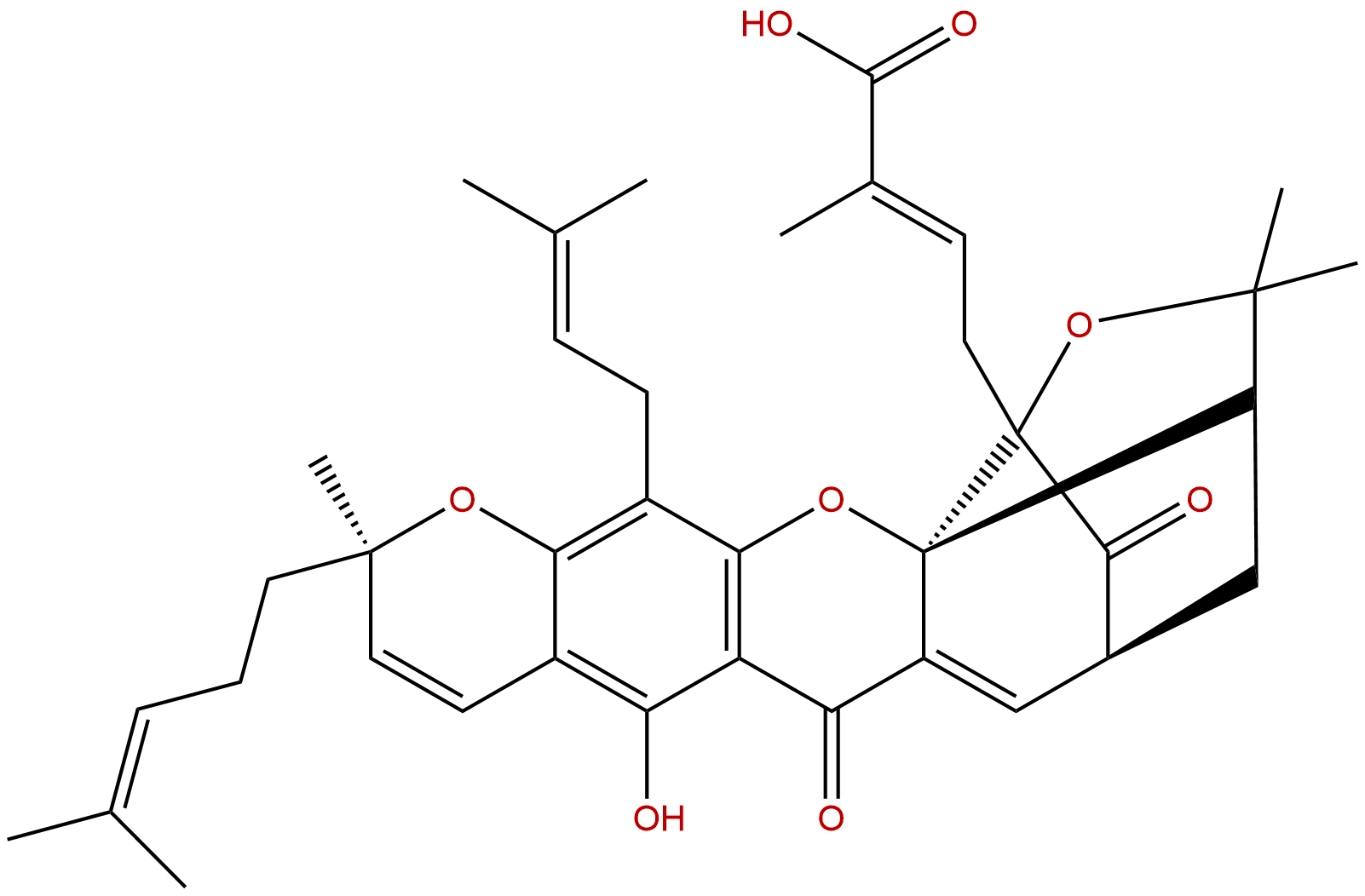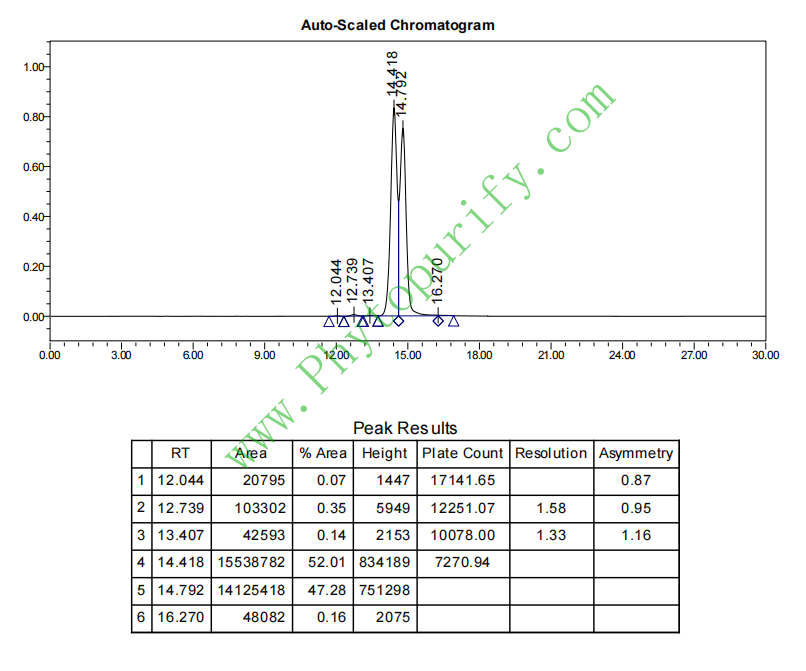
Gambogic acidCAS No.:2752-65-0
|
||||||||||
 |
|
|
||||||||

| Catalogue No.: | BP0613 |
| Formula: | C38H44O8 |
| Mol Weight: | 628.762 |
Product name: Gambogic acid
Synonym name: Guttic acid; Guttatic acid; β-Guttilactone; alpha-Gambogic acid; β-Guttiferin
Catalogue No.: BP0613
Cas No.: 2752-65-0
Formula: C38H44O8
Mol Weight: 628.762
Botanical Source: Garcinia hanburyi Hook.f.
Physical Description:
Type of Compound: Miscellaneous
Purity: 95%~99%
Analysis Method: HPLC-DAD or/and HPLC-ELSD
Identification Method: Mass, NMR
Packing: Brown vial or HDPE plastic bottle
Storage: Store in a well closed container, protected from air and light. Put into refrigerate or freeze for long term storage.
Whenever possible, you should prepare and use solutions on the same day. However, if you need to make up stock solutions in advance, we recommend that you store the solution as aliquots in tightly sealed vials at -20℃. Generally, these will be useable for up to two weeks.
The product could be supplied from milligrams to grams
Inquire for bulk scale.
Description:
Gambogic acid is a tissue-specific proteasome inhibitor, which has anticancer, anti-inflammatory, and anti-angiogenesis activities. Gambogic acid induces LRIG1 (leucine-rich repeat and Ig-like domain-containing-1) upregulation, which is responsible for EGFR (epidermal growth factor receptor) degradation and its downstream Akt/mTORC1 inhibition.
References:
Cell Biochem Biophys. 2013 Sep;67(1):199-206.
Gambogic acid sensitizes ovarian cancer cells to doxorubicin through ROS-mediated apoptosis.
Ovarian cancer is one human malignancy which has response portly to doxorubicin. The anti-cancer activity of Gambogic acid has been tested in in vitro and in vivo studies.
METHODS AND RESULTS:
In this study, we showed that Gambogic acid, a natural compound, could potentiate the anticancer activity of doxorubicin in ovarian cancer through ROS-mediated apoptosis. Platinum-resistant human ovarian cancer cell line (SKOV-3) was treated with Gambogic acid, doxorubicin, or the combination of both to investigate cell proliferation and apoptosis. We found that the combination of Gambogic acid and doxorubicin causes synergistic loss of cell viability in SKOV-3 cells and this synergistic effect correlated with increased cellular ROS accumulation. Moreover, in vivo results showed that Gambogic acid and doxorubicin combination resulted in a synergistic suppressing effect on tumor growth in ovarian cancer mice model.
CONCLUSIONS:
Taken together, the results suggested that doxorubicin in combination with Gambogic acid might provide a promising therapeutic strategy to enhance chemosensitivity of ovarian cancer to doxorubicin.
Cancer Res. 2008 Mar 15;68(6):1843-50.
Gambogic acid inhibits angiogenesis and prostate tumor growth by suppressing vascular endothelial growth factor receptor 2 signaling.
Gambogic acid (GA), the main active compound of Gamboge hanburyi, has been previously reported to activate apoptosis in many types of cancer cell lines by targeting transferrin receptor and modulating nuclear factor-kappaB signaling pathway. Whether GA inhibits angiogenesis, which is crucial for cancer and other human diseases, remains unknown.
METHODS AND RESULTS:
Here, we found that GA significantly inhibited human umbilical vascular endothelial cell (HUVEC) proliferation, migration, invasion, tube formation, and microvessel growth at nanomolar concentration. In a xenograft prostate tumor model, we found that GA effectively inhibited tumor angiogenesis and suppressed tumor growth with low side effects using metronomic chemotherapy with GA. GA was more effective in activating apoptosis and inhibiting proliferation and migration in HUVECs than in human prostate cancer cells (PC3), suggesting GA might be a potential drug candidate in cancer therapy through angioprevention with low chemotoxicity. Furthermore, we showed that GA inhibited the activations of vascular endothelial growth factor receptor 2 and its downstream protein kinases, such as c-Src, focal adhesion kinase, and AKT.
CONCLUSIONS:
Together, these data suggest that GA inhibits angiogenesis and may be a viable drug candidate in antiangiogenesis and anticancer therapies.
Mediators Inflamm. 2014;2014:195327.
Potent anti-inflammatory and antiproliferative effects of gambogic acid in a rat model of antigen-induced arthritis.
We have previously reported a continuous activation of caspase-1 and increased interleukin (IL)-1β levels in early rheumatoid arthritis (RA). These observations raised the hypothesis that drugs targeting the IL-1β pathway, in addition to tumour necrosis factor (TNF), may be particularly effective for early RA treatment. We have recently identified Gambogic acid as a promising therapeutic candidate to simultaneously block IL-1β and TNF secretion. Our main goal here was to investigate whether Gambogic acid administration was able to attenuate inflammation in antigen-induced arthritis (AIA) rats.
METHODS AND RESULTS:
Gambogic acid was administered to AIA rats in the early and late phases of arthritis. The inflammatory score, ankle perimeter, and body weight were evaluated during the period of treatment. Rats were sacrificed after 19 days of disease progression and paw samples were collected for histological and immunohistochemical evaluation. We found that inflammation in joints was significantly suppressed following Gambogic acid administration. Histological and immunohistochemical evaluation of treated rats revealed normal joint structures with complete abrogation of the inflammatory infiltrate and cellular proliferation.
CONCLUSIONS:
Our results suggest that Gambogic acid has significant anti-inflammatory properties and can possibly constitute a prototype anti-inflammatory drug with therapeutic efficacy in the treatment of inflammatory diseases such as RA.
HPLC of Gambogic acid
